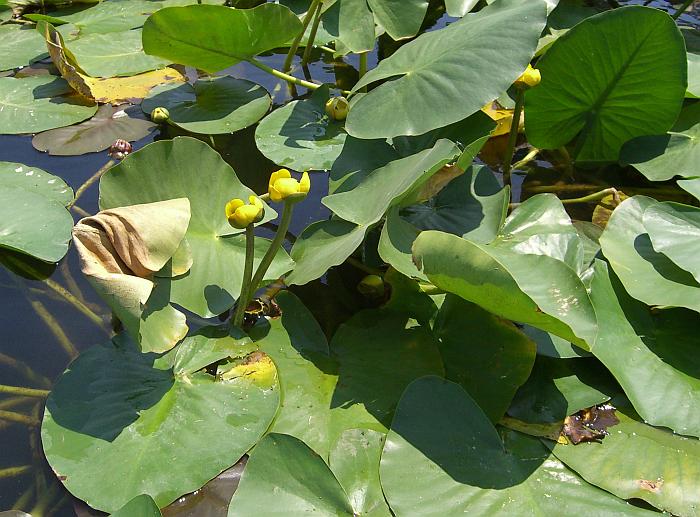Nuphar advena (Aiton) W.T. Aiton
Spatterdock

Native
CC = 6
CW = -5
MOC = 36
© SRTurner
Nuphar advena (Aiton) W.T. AitonSpatterdock | |
 |
Native CC = 6 CW = -5 MOC = 36 |
© SRTurner |
|
Family - Nymphaeaceae Habit - Perennial aquatic forb. Stems - Submerged rhizomes relatively stout, sometimes somewhat flattened, light yellow, not producing tubers. Leaves - Submerged or more commonly floating or emergent; the submerged (overwintering and juvenile) leaves membranous (the margins appearing undulate or crisped), short-petiolate; the floating and emergent leaves leathery and mostly long-petiolate. Leaf blades 6-40 cm long and wide, nearly circular to ovate or broadly elliptic-ovate, rounded at the tip, the bases deeply cordate, the lobes rounded at the tip, mostly bright green, the upper surface of emergent leaves usually shiny, the undersurface glabrous or occasionally sparsely short-hairy, the venation mostly pinnate. Petioles spongy.
Flowers - Flowers emergent or appearing floating, 1.8-4.5 cm in diameter when open, hypogynous, the stalk relatively stout, glabrous or occasionally sparsely hairy. Sepals 6, 1.0-2.3 cm long, elliptic to oblong-elliptic, broadly ovate or nearly circular, rounded to truncate or very shallowly notched at the tip, strongly concave, ascending to somewhat spreading and remaining cupped around the pistil at flowering, the outer 3 or 4 sepals smaller, green or reddish-tinged on one or both surfaces, the inner 3-5 sepals larger, green (occasionally reddish-tinged) toward the base and on the outer surface, yellow or sometimes reddish-tinged above the often green basal portion on the inner surface, more or less persistent at fruiting. Petals numerous, inconspicuous, reduced to relatively thick, oblong, scalelike organs positioned below and similar in size and shape to the stamens, shorter than the sepals. Stamens 3-9 mm long, mostly truncate at the tip. Ovary superior, the perianth and stamens attached at its base. Stigmatic disc 6-28 mm in diameter, circular, unlobed, with 8-24, raised, linear to narrowly oblong or narrowly lanceolate, stigmatic regions.
Fruits - Capsular, 1.5-5.5 cm long, globose to ovoid, somewhat ribbed longitudinally, green or reddish-tinged, irregularly dehiscent around the basal portion with age. Seeds obovoid, 3-6 mm long, the surface smooth, green to brown
Flowering - May - October. Habitat - Ponds, sloughs, stagnant portions of watercourses. Origin - Native to the U.S. Lookalikes - The leaves can be mistaken for those of Nymphaea odorata (water lily). Other info. - In Missouri this species is found mostly in the southern half of the state. Its continental U.S. distribution is somewhat scattered across most of the eastern half of the country. When in flower this plant is easily recognized, though usually difficult to observe closely due to its aquatic habitat. Photographs taken at Busch Wildlife Area, St. Charles County, MO, 6-29-2012, and at Noblett Lake, Douglas County, MO, 6-2-2017 (SRTurner). |